|
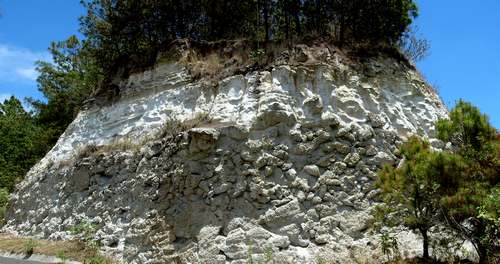 One of the attractions of the new
geopark will be The Giant Pumice Horizon, easily viewed inside
Jalisco's Primavera Forest. Within the Horizon you can see blocks of
pumice up to eight meters in diameter. One of the attractions of the new
geopark will be The Giant Pumice Horizon, easily viewed inside
Jalisco's Primavera Forest. Within the Horizon you can see blocks of
pumice up to eight meters in diameter.
By John Pint
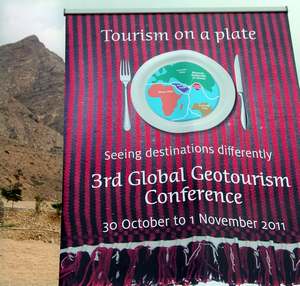 It all began in the Sultanate of Oman
where—thanks to a strange concatenation of events—I found myself
attending the Third
Global Geotourism Conference in the fall of 2011. While
preparing for this event, I discovered the existence of the Global
Geoparks Network, UNESCO’s organization of 90 geoparks in 27 countries
of the world, where tourists can see and, better yet, understand the
world’s most outstanding geological phenomena. It all began in the Sultanate of Oman
where—thanks to a strange concatenation of events—I found myself
attending the Third
Global Geotourism Conference in the fall of 2011. While
preparing for this event, I discovered the existence of the Global
Geoparks Network, UNESCO’s organization of 90 geoparks in 27 countries
of the world, where tourists can see and, better yet, understand the
world’s most outstanding geological phenomena.
I had planned to give a presentation at the conference on the
extraordinary biodiversity and geodiversity all around the city of
Guadalajara, an area I began calling “The
Magic Circle” in 2010 after discovering that all five of
Mexico’s eco-systems converge in close proximity to this city, the
second-biggest metropolis in the county.
Naturally, I asked myself whether any of the geological features near
Guadalajara might qualify for inclusion in a UNESCO Geopark. I decided
to pose the question to a friend and neighbor, Canadian geologist Chris
Lloyd.
“Can you think of any place in western Mexico,” I asked him, “that is
geologically rare and at the same time suitable for demonstrating
geological processes to the Man on the street?”
Chris looked at me and said, “John, you don’t have to go anywhere to
find a site like that. All you have to do is step out your door and
walk down the hill.”
Thus, did I
discover that I live right on the edge of what geologists call The
Comenditic Dome and Ash Flow Complex of Sierra La Primavera.
“Geologists come here from all over the world to see the Primavera
Caldera,” said Lloyd, “but they usually study it from the western
extension of Mariano Otero Street. Actually, the arroyo right here at
the edge of Pinar de la Venta is much better for understanding the
creation of the Giant Pumice Blocks, which, of course, only occur in a
few places in the whole world.”
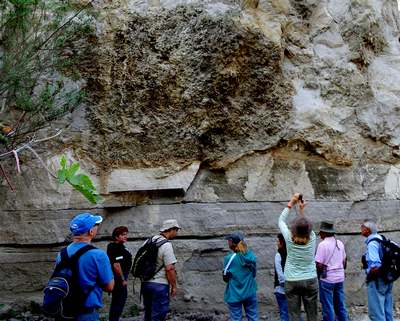 Giant Pumice Blocks? A potential geopark in my
own backyard? “It could only happen in Mexico,” I said to myself as I
walked with Chris down to the Río Seco, a deep arroyo which separates
my community from the Primavera Forest. Soon we stood at the base of a
vertical canyon wall about 50 meters tall. “Welcome to the Primavera
Caldera,” intoned the geologist with a big smile. Giant Pumice Blocks? A potential geopark in my
own backyard? “It could only happen in Mexico,” I said to myself as I
walked with Chris down to the Río Seco, a deep arroyo which separates
my community from the Primavera Forest. Soon we stood at the base of a
vertical canyon wall about 50 meters tall. “Welcome to the Primavera
Caldera,” intoned the geologist with a big smile.
Now a caldera is a most interesting phenomenon. It’s a big hole which
is left after a huge volcanic explosion. The whole process happens so
suddenly that there is no time for a volcano to form. This particular
explosion, I learned, took place 95,000 years ago and it was no small
thing. Twenty-four cubic kilometers of rock and dust were thrown up
into the air, putting the Primavera Caldera solidly on the list
(although not at the top) of the World’s Greatest Explosions.
Eventually, the 11-kilometer-long crater filled with water and became a
lake for at least 10,000 years. “See the horizontal lines on the canyon
wall?” said Chris, “Each is a layer of sediment formed at the bottom of
that lake.”
Right on top of all those strata of sediment, I could see a thick band
of something completely different: a layer composed of ash and enormous
chunks of pumice typically from four to six meters in diameter. It
seems some 25-30,000 years ago, there was a Mt-St-Helen’s type eruption
from a volcano at the southeast end of the lake, near the modern-day
subdivision of Bugambilias. Giant blocks of pumice enclosed in a
pyroclastic cloud were shot into the air and landed in the lake where
they floated for a while until sinking to the bottom, forming a thick
layer which geologists now call the Giant Pumice Horizon.
Hot River and
Hissing Fumaroles
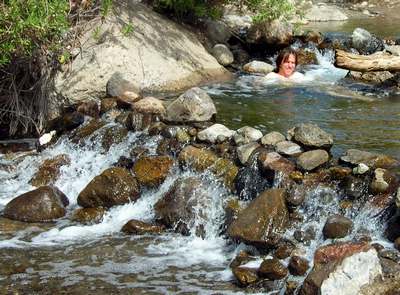 Apart from canyon walls
that show us the history of the caldera, the present-day Primavera
Forest has other outstanding geological features, such as Río Caliente,
a hot river which starts out with temperatures as high as 70° C (158°
F) but is quickly joined by numerous hot and cold springs, providing a
delightful, hot, bubbly, “natural Jacuzzi” experience to countless
thousands of bathers yearly. In addition to hot rivers, the Primavera
Caldera also has dramatically hissing, sputtering fumaroles. Some of
these have produced miniature forests of delicate, featherlike sulfur
crystals, a veritable Little Yellowstone that few visitors to the
Primavera have ever seen. Apart from canyon walls
that show us the history of the caldera, the present-day Primavera
Forest has other outstanding geological features, such as Río Caliente,
a hot river which starts out with temperatures as high as 70° C (158°
F) but is quickly joined by numerous hot and cold springs, providing a
delightful, hot, bubbly, “natural Jacuzzi” experience to countless
thousands of bathers yearly. In addition to hot rivers, the Primavera
Caldera also has dramatically hissing, sputtering fumaroles. Some of
these have produced miniature forests of delicate, featherlike sulfur
crystals, a veritable Little Yellowstone that few visitors to the
Primavera have ever seen.
Fairy
Footstools and Magic Rocks
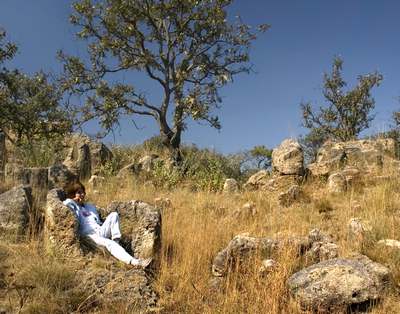 In the western half of the Primavera Forest lie
hundreds of bizarrely shaped rocks. Some of them look like giant
bathtubs, sofas and armchairs, others resemble long, smooth, curving
fences or walls. Most curious of all are the “Fairy
Footstools” which, from a distance, look just like tree
stumps but are, in fact, made of rhyolite rock. Dig a hole next to what
looks like a stump and you’ll discover that they are just the tips of
very long, smooth lithic cylinders. Geologists refer to them as “Fossil
Fumaroles." In the western half of the Primavera Forest lie
hundreds of bizarrely shaped rocks. Some of them look like giant
bathtubs, sofas and armchairs, others resemble long, smooth, curving
fences or walls. Most curious of all are the “Fairy
Footstools” which, from a distance, look just like tree
stumps but are, in fact, made of rhyolite rock. Dig a hole next to what
looks like a stump and you’ll discover that they are just the tips of
very long, smooth lithic cylinders. Geologists refer to them as “Fossil
Fumaroles." A
very fine book on the geology of the Primavera Forest was published in
March, 2013. "La Apasionante Geología del Area de Protección de Flora y
Fauna La Primavera" by Barbara Dye has 72 full-color pages of photos,
drawings and sketches and easy-to-follow descriptions of the exciting
geology of this unusual caldera (Book Review). Outside
the confines of the proposed Geopark, lie a great many fascinating
geosites many of which could become "partners" with the Park at some
point. Below follows a list of some of these places.
El Diente Monoliths
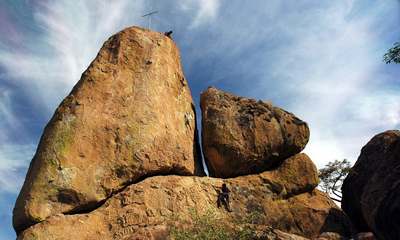 A ten-minute ride north
of Guadalajara brings visitors into a forest of giant monoliths,
popularly known as El
Diente. These huge rocks are composed of a rather pure
feldspar porphyry which formed deep under the earth perhaps up to 30
million years ago. That’s how long it’s taken the surrounding rock to
erode away, leaving these extremely old monoliths standing tall. El
Diente is a Protected Area and a favorite site for rock climbers as
well as for families looking for a place to take a walk and have a
picnic. For geologists, however, El Diente is a very special place
indeed. A ten-minute ride north
of Guadalajara brings visitors into a forest of giant monoliths,
popularly known as El
Diente. These huge rocks are composed of a rather pure
feldspar porphyry which formed deep under the earth perhaps up to 30
million years ago. That’s how long it’s taken the surrounding rock to
erode away, leaving these extremely old monoliths standing tall. El
Diente is a Protected Area and a favorite site for rock climbers as
well as for families looking for a place to take a walk and have a
picnic. For geologists, however, El Diente is a very special place
indeed.
Giant Stone Balls
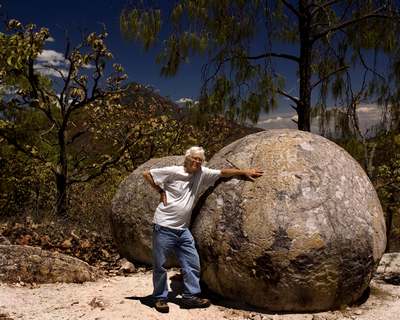 Within a short distance of
the Primavera Forest-Caldera, lie several other extraordinary
geological sites which could become partners with the new Geopark. Forty
kilometers to the west there is a hilltop covered with almost perfectly
round stone balls up to three meters in diameter. The
Piedras Bola, as they are called, so intrigued geologists
that National Geographic sent a team to Jalisco to unravel the mystery
of these megaspherulites’ origins and to publish the results (See their
August, 1958 issue). More than 70 of these round rocks have been
catalogued by a team from the University of Guadalajara (UDG) and it is
thought that hundreds more lie beneath the surface Within a short distance of
the Primavera Forest-Caldera, lie several other extraordinary
geological sites which could become partners with the new Geopark. Forty
kilometers to the west there is a hilltop covered with almost perfectly
round stone balls up to three meters in diameter. The
Piedras Bola, as they are called, so intrigued geologists
that National Geographic sent a team to Jalisco to unravel the mystery
of these megaspherulites’ origins and to publish the results (See their
August, 1958 issue). More than 70 of these round rocks have been
catalogued by a team from the University of Guadalajara (UDG) and it is
thought that hundreds more lie beneath the surface
Obsidian
Field and Workshops
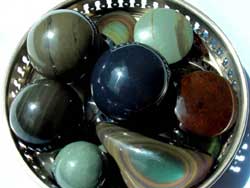 Jalisco has the third
largest obsidian fields in the world. One of the most important of
these is El Pedernal, which is found 25 kilometers west of the
Primavera Forest, near Teuchitlán. Its obsidian is of a very high
quality and comes in many other colors beside black. Jalisco has the third
largest obsidian fields in the world. One of the most important of
these is El Pedernal, which is found 25 kilometers west of the
Primavera Forest, near Teuchitlán. Its obsidian is of a very high
quality and comes in many other colors beside black.
What is thought to be the world’s
largest and oldest obsidian workshop, Itztlitlan, is today
known as the former island of Las Cuevas, located 13 kilometers south
of Magdalena. Archaeologists have proven that high quality obsidian was
worked here continuously for 2000 years and tools from here made their
way as far north as what is today the US state of Arizona.
The Three
Major Types of Volcanoes
The Primavera is an outstanding example of a Caldera Volcano. Only 30
kilometers away, visitors can walk through the picturesque
crater of Tequila Volcano, a stratovolcano featuring one of the world’s
best examples of an uplifted volcanic plug. A safe, yet exciting via
ferrata can be constructed up to the very top. Good examples of the
third type of volcanoes, scoria cones, are found just east of
Guadalajara. This means that all three of the major types of volcanoes
can easily be visited in one day.
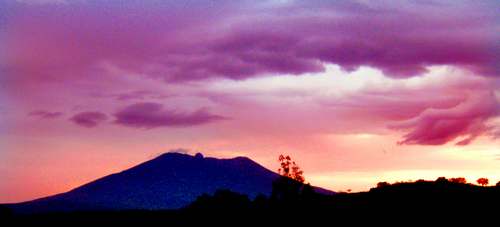
Tequila Volcano
The Opal Mines of Magdalena
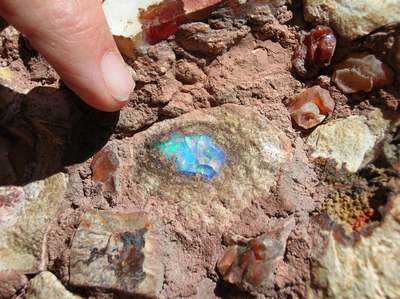 Hundreds of opal mines lie 50 kilometers
northwest of the Primavera Caldera, near Magdalena. Wielding a miner’s
pick, visitors can find their own opals or purchase finely crafted opal
jewelry in Magdalena. Hundreds of opal mines lie 50 kilometers
northwest of the Primavera Caldera, near Magdalena. Wielding a miner’s
pick, visitors can find their own opals or purchase finely crafted opal
jewelry in Magdalena.
Guadalajara, it seems, has an abundance of outstanding geological
phenomena which fit the requirements for a UNESCO Geopark. Will it
happen? An ad-hoc committee has been talking about just this subject
for months, discussing the possibilities of creating a Geopark in
Jalisco with the help of Geopark experts living as far away as Iran and
China and with the local support of Bosque La Primavera. Here's hoping
that Jalisco authorities will be just as enthusiastic!

It
is proposed that the Bosque La Primavera Protected Area be declared a
Geopark.
The red elipse encloses other remarkable geosites, indicated by
green triangles, which could become "partners" with the new Geopark.
|

